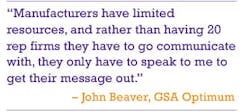Sponsored
Electrical manufacturers’ independent representatives are the quintessential local market players, elite squads of ace salespeople who make it their business to know everybody in town and what it takes to get each one to sign an order. They live what looks from outside like a precarious existence, commission sales based on relationships that are always subject to cancellation, usually on 30 days’ notice. Despite that tenuous “kill to eat” structure, or maybe because of it, reps all over the country have built thriving careers around independent sales and many have built agencies that last multiple generations.
Because of the reps’ focus on deep local knowledge and expertise, even while electrical manufacturers and electrical distributors have gone through waves of consolidation, rep firms have remained comparatively small. That is beginning to change.
In the past year alone we’ve reported on a number of significant mergers among rep agencies. In New England, Yusen Associates’ subsidiary Illuminate Boston merged with Vanguard Lighting in January; One Source Associates acquired Paolicelli & Associates in western Pennsylvania and West Virginia in May; R/B Sales acquired Kansas City’s Precision Electrical Sales, and Ewing-Foley merged with Phoenix-based Miller Electrical Sales in July; and Thea & Schoen acquired William B. Bleiman & Sons in November, just to name a few high-profile deals.
Tom and TJ O’Connor of Farmington Consulting Group (FCG) pointed out the trend toward rep consolidation and the driving forces behind it in a study on the rep of the future for the National Electrical Manufacturers Representatives Association (NEMRA) and a three-part report in Electrical Wholesaling last year.
“Some manufacturers and distributors who responded to the survey said many territories have weak rep agencies unwilling to invest in the right technologies or the right people, or don’t have their organization designed properly. Owners of these rep firms, they said, are harvesting their incomes, not reinvesting in their agencies.
“Manufacturers have been approaching large and mid-size reps to look at these strategic geographic targets and acquire these aging agencies with weak management succession plans. Some platform manufacturers are replacing their smaller, weaker independent manufacturers’ representatives with stronger, larger reps,” the O’Connors said in their report.
At the street level, conversations with some of the reps involved in these consolidations show the driving forces behind the trend and the benefits and challenges of merging rep agencies.
As agency owners near retirement age, the need to get some value out of a lifetime or multiple generations of work and investment drives a lot of the consolidation from the seller side. Succession planning in a rep agency can be an extreme challenge. Jeffry Bleiman of William B. Bleiman & Sons knows this first-hand.
“Our business has been around for about 78 years. It was always a family business, but I didn’t have a fourth generation to give it to,” Bleiman says. He tried at least two different approaches to building a succession plan only to see them fall through before agreeing to merge his firm with Thea & Schoen. “You try to find the right person, and I thought I had the right person, but then a distributor came up and stole him for a ridiculous price, a third more than I was paying him, after four or five years of training him from not knowing the business.” His second attempt also failed, due to a non-compete clause.
In looking for other succession options Bleiman recognized that the electrical markets in the Mid-Atlantic states were merging. “When you look at the New York City, northern Jersey, Philadelphia, South Jersey, Delaware, DC area, the markets are merging. Distributors are all expanding, some in the south going north, some in the north going south. The Theas and I talked about this, and we realized this whole segment is merging to where they really want one agent to handle it.” It made sense to Bleiman to make his team part of that larger agency.
For a rep looking to build a larger geographic presence, the challenge of succession planning creates opportunities. It’s often the manufacturers who make the introductions, as the NEMRA/FCG report found.
John Beaver, owner of GSA Optimum, Oakdale, NY, an electrical and electronics agency that after seven acquisitions is now active in markets from Maine down the East Coast to Virginia, says manufacturers have brought him some of his best opportunities.
“It’s been driven by manufacturers, not so much by me,” Beaver says. “Manufacturers have limited resources, and rather than having 20 rep firms they have to go communicate with, they only have to speak to me to get their message out.”
Beaver has also found acquisition prospects through membership in various rep associations. He is this year’s chairman of the Manufacturers’ Agents National Association (MANA) and also an active member of NEMRA and the Electronics Representatives Association (ERA).
Manufacturers’ interest in working with larger reps is largely a desire for reps with more capabilities, says Tom O’Connor of FCG. “Top tier manufacturers have raised their expectations of rep capabilities and performance, i.e. rep investments in strategic business planning, an in-house marketing person, CRM tools, Millennial employees, a sound management succession plan, strong sales management processes, demand creation salespeople, etc.”
Investing in those sorts of expanded capabilities requires more revenue.
Bill Devereaux, owner of R/B Sales, Marion, Iowa, was feeling he had grown his market share as much as he could. “My driving motivation was we’re in our middle 40s, we’ve got 10 to 15 years of gumption left,” he says. “What we’ve done in Iowa and Nebraska, because we’ve been fortunate to have distributors who work so well with us, our market share was so high that we couldn’t grow any more than we were. We grew from $9 million to $90-plus million in the same geography and there just wasn’t enough people to sell to, to grow.”
The chance to acquire Precision, an established rep in Kansas City built like R/B Sales around the Hubbell brands and serving more densely populated markets in Kansas and Missouri, opened new growth opportunities. “R/B Sales, until July 31 of 2016, had been in the same geography for 37 years. We’re now in an area with 140% more population than a year ago this time,” Devereaux says.
The increased revenue from covering more territory allows reps like R/B Sales to invest in systems and expertise they couldn’t otherwise have justified. For example, the expansion gives the agency enough volume to make inside sales staff more specialized, says Dan Riedell, R/B Sales’ vice president of operations. “We have more ability to specialize salespeople now, so we can give them focus we couldn’t have otherwise. We’re able to create true champions in inside sales. Instead of putting them on five or six manufacturers, we can have someone focused on one or two manufacturers because the volume warrants the time they’re taking.”
One of the biggest challenges for reps looking to consolidate across new geographic territories lies in resolving conflicts among competing lines to put together a viable package in each territory. Making manufacturers comfortable and confident that a rep will honor its commitments not to give information to competing manufacturers takes a lot of work, and some won’t go for it under any conditions. Devereaux says this is a critical issue that the industry needs to address.
“I think agencies have to be able to have a set system or protocol were they can show manufacturers that have these concerns a true separation in duties, and in flow of information, so they’re not so worried about information bleeding across markets,” he says. “And agents have to be prepared to deal with those conflicts.”
The same concern has led Beaver to keep distinct territories. “That’s why we’ve kept the territories along the NEMRA lines,” he says. “If we have one line in one territory and not in another, or we have competing lines in different territories, a firewall is needed between territories and that’s why they’re still broken up. They all have different names so they understand there is a firewall.”
Running a larger, more dispersed agency also requires a very different management style than a smaller firm. Beaver of GSA Optimum no longer calls on accounts and instead spends his days traveling to the firm’s many offices to make sure the quality and culture are consistent across his territories.
The advantages of size come with some trade-offs, says Charlie Cohon, CEO of MANA, a rep association whose members come from a variety of vertical markets. “One benefit we’ve always said manufacturers get from manufacturers’ reps is a variety of input from variety of small companies. A multitude of rep firms managed by multiple independent manufacturers’ reps gives you more diverse market insights. You get a cross-pollination with other lines. When you increase uniformity, you decrease diversity.”
Will there come a day when the electrical industry has nationwide rep firms? It’s been done in other industries such as food products, but every industry has very different dynamics. Ken Hooper, CEO of NEMRA, thinks it’s not likely anytime soon.
“It’s hard to see reps going national right now, though I know they exist in other areas,” Hooper says. “I can’t see that happening in electrical because there’s too much ‘all sales are local’ mentality. With reps having built up so much equity in their local relationships, for somebody to try to nationalize that, I think it becomes very difficult. It requires a whole new management structure and we’re years away from that.”
Beaver doesn’t see why a national rep wouldn’t be possible. He points to examples such as real estate agents, a distinctly local-knowledge based business, where nationwide firms such as Coldwell Banker have nonetheless been able to put together a consistent nationwide presence.
Regardless of how big firms get on the top end of the scale, there will always be a place for smaller reps, Cohon of MANA says. Individual salespeople working for larger firms will always strike out on their own, like an iceberg calving off a glacier.
There’s a constant inflow of new manufacturers looking for representation and they have concerns about getting lost with a larger rep firm, says Hooper, particularly in the lighting market lately.
For distributors, because local reps are such crucial partners, a change of rep ownership can be destabilizing. Handling such a transition requires all the people skills you’ve got. Hooper of NEMRA points out that distributors can benefit from taking the opportunity to more closely align with their reps.
“It gets back to really choosing up sides and trying to align with reps in your territories,” Hooper says. “If your relationship with a rep is $X million and it goes to 5x, it’s important for distributors and reps to sit down and see where they can make alliances because there’s synergies to having the rep tuned into what the distributor is trying to do. It takes time and effort and analysis.”
In the trend toward larger rep firms and more focus on professional practices among reps large and small, distributors in the electrical industry need to continue working on those relationships and should get comfortable with long-time sticking points such as sharing point-of-sale and point-of-transfer data with reps. NEMRA recently introduced new industry standards for POS/POT data. Reps will be more supportive of distributors whose operations make it easier for the rep to get compensated for their work, Hooper says.




